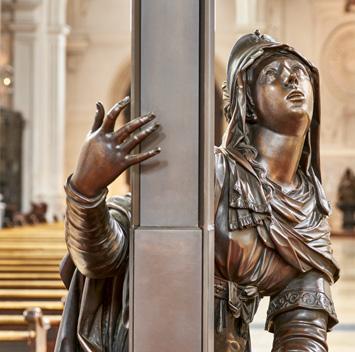
3 minute read
19 Damascene Mirror
from JB Test 01/22
Crucifixion Group with Christ and Mary Magdalene
20
Advertisement


CRUCIFIXION GROUP WITH CHRIST AND MARY MAGDALENE
Southern Germany
Late 16th/early 17th century
Boxwood Heights: Christ: 26 cm, Maria Magdalene: 14.3 cm
Added nipple inserts on figure of Christ and buttons on Mary Magdalene’s garment
Related literature: Giambologna. Triumph des Körpers, exh. cat. Kunsthistorisches Museum Vienna, 27 June–17 September 2006, Milan 2006, pp. 162-65. Silberhirsch und Wunderprunk in der Kunstkammer Würth, exh. cat. Kunsthalle Würth, Schwäbisch Hall, 18 May 2015-10 January 2016, Passau 2015, pp. 168-169.
The motif of the sinner Mary Magdalene kneeling before the Cross was very popular, especially in southern Germany. This is due to one magnificent example of such a group of figures. The famous FlemishItalian Baroque artist Giambologna created several crucifixes that were to influence sculpture from the 1570s onwards. One is to be found today in the Jesuit church of St. Michael’s in Munich. He cexecuted the crucifix in 1594 in Florence. Giambologna’s German master pupil, Hans Reichle (1565/70 Schongau–1642 Brixen) added the figure of Mary Magdalene in 1595. Her posture is dramatically moving and her imploring gaze looks up at Jesus’ face (fig. 1). She symbolises the faithful sinner seeking redemption.
A present from Ferdinando de‘ Medici to William V, Duke of Bavaria, the crucifix was sent from Florence to Munich. It was intended to decorate William’s projected tomb in the Jesuit church that was built from 1583 onwards. The project, however, was never completed. Only the crucifix with the mourning figure of Mary Magdalene was installed in St. Michael’s as a figurative group. Not only the Jesuits marvelled at this masterpiece there which soon became well-known beyond Munich. Numerous artists visited the church to look at the work that was praised for ‘the beauty of its craftsmanship and masterly execution’.1 Another small Crucifixion group with Mary Magdalene, c. 1620, Southern Germany (Augsburg or Munich) is in the Sammlung Würth. (fig. 2)
Jean de Boulogne (Johannes of Boulogne) who came from Flanders travelled from Doway to Italy where he called himself Giovanni Bologna. While in the service of the Medicis he created the Rape of the Sabine Women – a group of figures now on the Piazza della Signoria in Florence. The group also became a model for later sculptors just like his depiction of Christ that reflects the characteristic Classical ideal of the human body. His small bronze crucifixes, made together with his workshop under Antonio Susini, became widely sought-after among art collectors.
20
1 Cf. exh. cat., Vienna 2006, p. 164 and note 26.

The sculptor of our crucifixion group certainly came from the southern German region. His work bears a characteristic individual style. One particular feature is the fine execution of detailing such as that on Mary Magdalene’s garment and her hair, as well as the tears on her face. The figure of Christ has notable ornamentation on the loin cloth and in the treatment of the hair and beard. Even the hair under his arms is carved; the nipples, however, have been inserted separately. To date it has not been possible to identify the sculptor.

Fig. 1. Crucifixion group in the Jesuit church of St. Michael’s, Munich; Christ (1594) by Giovanni da Bologna (1529-1608); figure of Mary Magdalene (1595) by Hans Reichle (1565-70 Schongau-1642 Brixen), Detail

Fig. 2. Crucifixion group with Mary Magdalene, c. 1620, Southern Germany (Augsburg or Munich), boxwood figures, walnut veneer pedestal, ebonised, 74 x 32 x 14 cm, Sammlung Würth, inv. no. 9357
20











